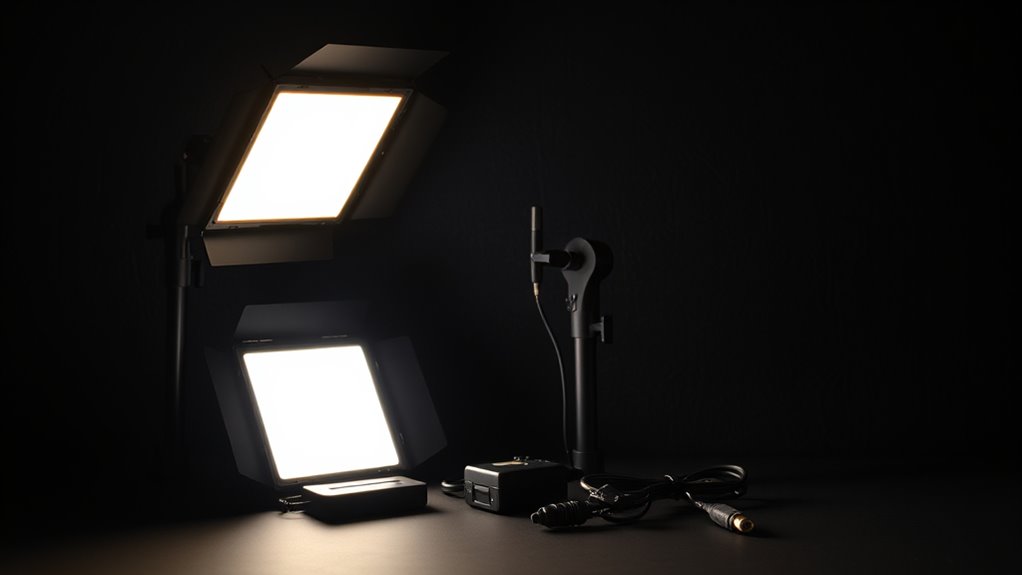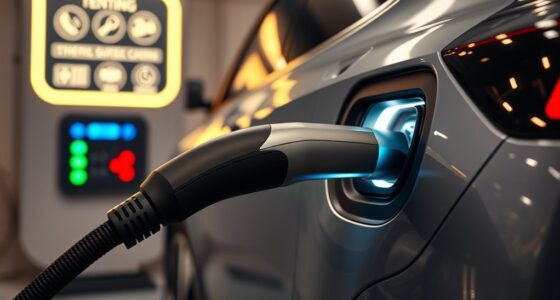If you’re new to blackout lighting, you’ll find simple options like lanterns and headlamps perfect for indoor and outdoor use. Choose weather-resistant, battery-powered, or solar-powered lights based on your needs, and always verify their safety features. Regularly maintain and test your supplies to ensure they work during emergencies. With the right setup, you stay safe and prepared. Keep exploring to discover how to select, manage, and extend your lighting solutions effectively.
Key Takeaways
- Choose indoor-specific or weather-resistant outdoor lighting kits with appropriate IP ratings for safety and durability.
- Use LED lanterns and headlamps for energy efficiency, long battery life, and versatile illumination during blackouts.
- Regularly inspect and charge batteries, store kits properly, and replace worn components to ensure emergency readiness.
- Follow safety guidelines by avoiding overloads, keeping lights away from fire hazards, and maintaining stable, accessible placement.
- Consider lighting duration, cost, and eco-friendly options like solar lights and rechargeable batteries for sustainable blackout preparedness.
What Types of Lighting Kits Are Available for Power Outages?
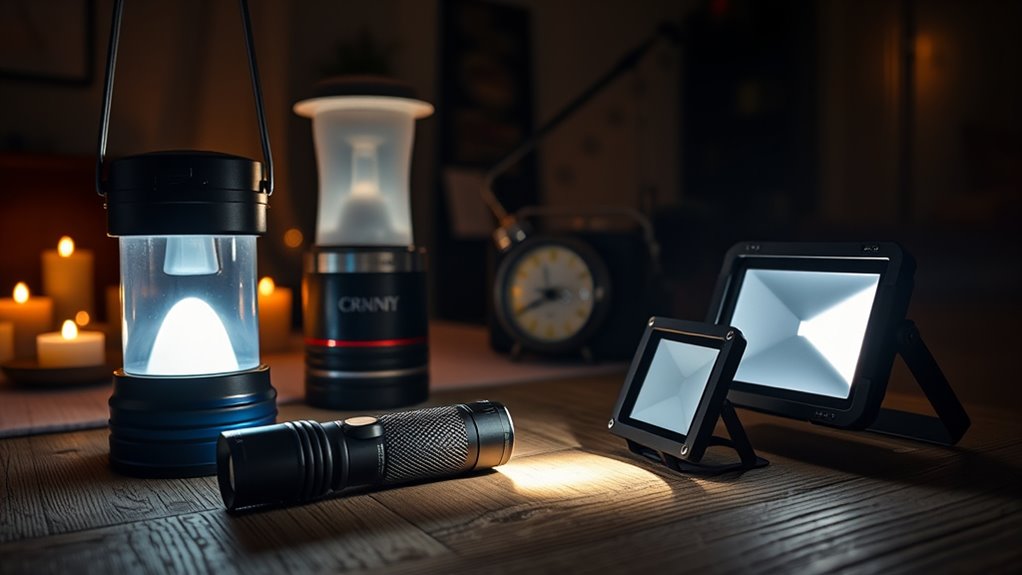
During a power outage, having the right lighting kit can make all the difference in maintaining safety and comfort. You’ll find several options, including portable lanterns and headlamps. Portable lanterns are versatile and easy to move around, providing broad, steady illumination for rooms or outdoor spaces. They’re perfect for lighting a larger area and can run on batteries or rechargeable power sources. Headlamps are compact and hands-free, making them ideal for tasks like searching for supplies or fixing equipment. They offer focused light directly where you look, which is especially useful when you need mobility or precision. Both portable lanterns and headlamps are essential components of a reliable blackout kit, ensuring you have adequate lighting in different scenarios. Using adjustable settings on your lighting devices can help optimize brightness and battery life during an outage.
How Do I Choose the Right Lighting Kit for My Home?
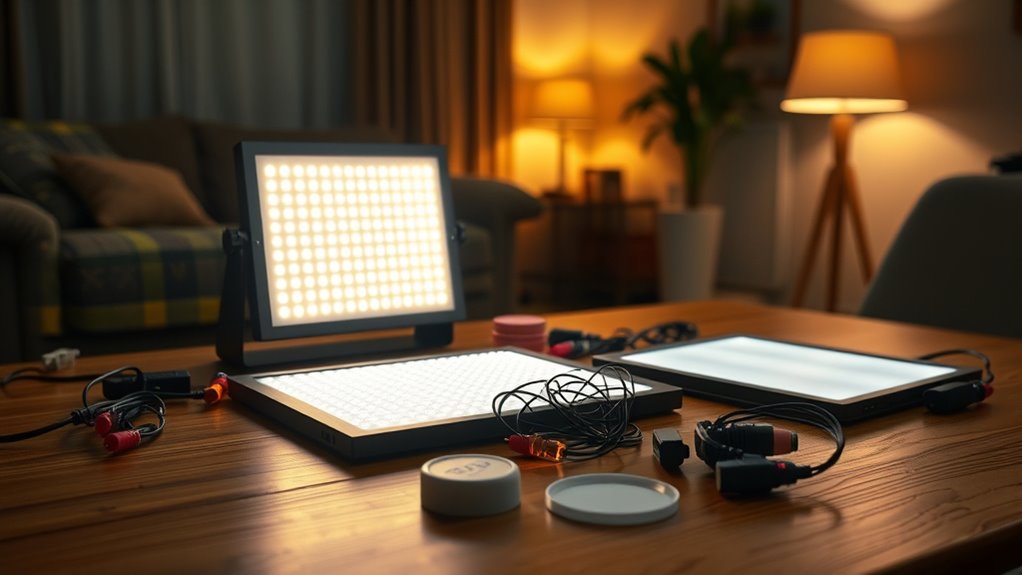
Choosing the right lighting kit for your home depends on your specific needs and the layout of your space. You should consider how much light you need during a blackout and where you’ll place the lights. Think about your home decor style to select a kit that complements your space, whether modern, rustic, or minimalist. Energy efficiency is also important; look for LED options that consume less power and last longer. Measure your rooms to determine the number and type of lights required, ensuring you have sufficient coverage. Keep in mind safety features like easy-to-use switches and secure mounting options. To improve your writing, you can detect passive voice and make your sentences more direct and engaging. By evaluating your lighting needs, decor preferences, and energy-saving goals, you’ll choose a kit that’s practical and enhances your blackout preparedness.
Are Battery-Powered or Solar Lights Better for Blackouts?

When choosing between battery-powered and solar lights for blackouts, you’ll want to take into account how reliable each power source is and how it impacts the environment. Cost also plays a big role, as upfront expenses and long-term savings can vary. Understanding these factors helps you pick the best lighting option for your needs. Additionally, energy efficiency can influence which option is more sustainable and cost-effective in the long run.
Power Source Reliability
Battery-powered lights often provide more reliable illumination during blackouts because they don’t depend on sunlight or external power sources. Instead, they rely on stored energy from backup batteries, ensuring consistent operation when the power grid goes down. Solar lights, while eco-friendly, depend on sunlight to recharge, which isn’t guaranteed during prolonged blackouts or cloudy days. Backup batteries in battery-powered lights can be replaced or recharged in advance, offering peace of mind. This makes them a dependable choice for emergency lighting, especially if you want to avoid interruptions. In contrast, solar lights may fade in performance if sunlight isn’t sufficient. Overall, for consistent reliability during emergencies, battery-powered lighting kits with backup batteries are the smarter option.
Environmental Impact
Battery-powered lights rely on stored energy in batteries, which can produce environmental concerns due to the manufacturing and disposal processes involved. These batteries often contain hazardous materials, and improper disposal can harm ecosystems. To minimize impact, look for lights that use eco friendly materials and promote energy conservation. Rechargeable batteries are a better option, as they reduce waste and require fewer replacements over time. Solar lights, on the other hand, harness renewable energy from the sun, making them more environmentally sustainable. They don’t produce harmful emissions and are generally more eco friendly overall. Choosing solar lights helps you lower your carbon footprint and supports energy conservation efforts, making them a smarter choice for eco-conscious blackout preparedness. Additionally, renewable energy sources like solar power significantly reduce reliance on non-renewable resources, further benefiting the environment.
Cost Considerations
Are solar lights a more cost-effective option than battery-powered alternatives for blackouts? In terms of budget options, solar lights often have higher upfront costs but lower ongoing expenses since they don’t need batteries replaced regularly. Battery-powered lights typically cost less initially but can become expensive over time due to the need for frequent battery replacements. If you prioritize long-term savings, solar lights may be more economical despite the initial investment. Consider your blackout frequency and available sunlight; solar lights work best with consistent sunlight exposure. Battery-powered options can be more flexible and immediate but might lead to higher costs in the long run. Contrast ratio and other projector features can influence the overall viewing experience, but for blackout lighting, weighing upfront costs against ongoing expenses helps you choose the most cost-effective lighting kit for your blackout preparedness.
What Safety Precautions Should I Follow When Using Emergency Lighting?
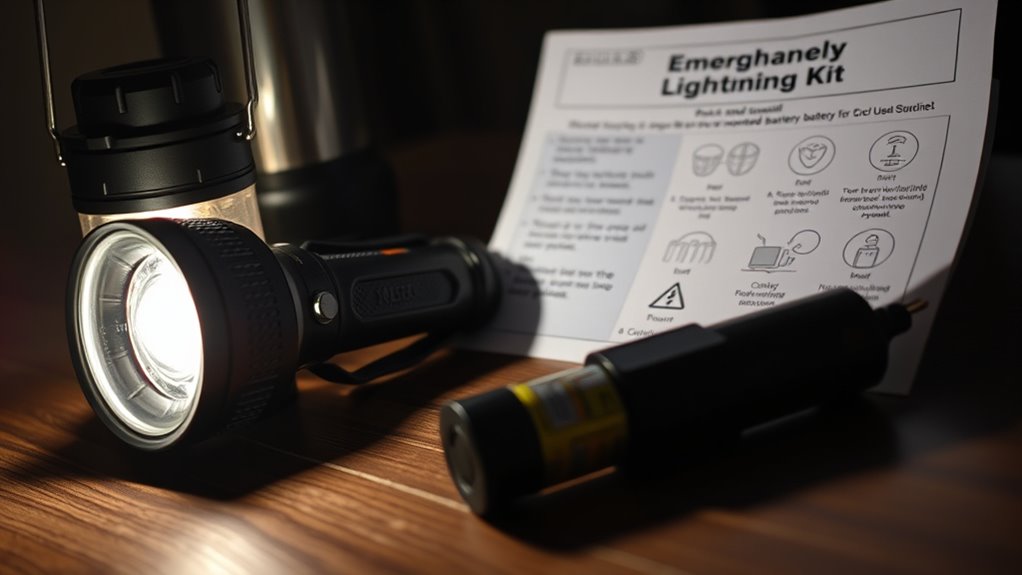
When using emergency lighting during a blackout, safety should always come first. Always inspect your lighting kits beforehand to verify they’re in good condition and fully charged. Keep emergency lights away from fire hazards, such as flammable materials or heat sources, to prevent accidents. Follow electrical safety guidelines by avoiding overloading outlets and not tampering with wiring. Place lights on stable surfaces to prevent falls or damage. Never cover emergency lights, as blocking vents can cause overheating. Use batteries and chargers as instructed, and replace any damaged components immediately. Keep a clear path to exits illuminated, avoiding clutter or obstacles. Properly maintaining and safely operating your lighting kits reduces risks and ensures they’re ready to provide reliable illumination when needed most. Additionally, understanding the different types of Pimple Patch can help in selecting the most suitable emergency skincare for unexpected breakouts.
How Long Do Different Lighting Options Last During a Power Outage?

Ever wonder how long your emergency lights will last during a blackout? The battery life of your lighting kit determines how long your lights stay on. Most rechargeable flashlights and lanterns last between 2 to 12 hours, depending on their capacity and usage. LED lights tend to have longer bulb longevity, often exceeding 50,000 hours, making them a reliable choice for extended outages. Incandescent bulbs usually last only a few hundred hours, so they may need more frequent replacements. Keep in mind that continuous use drains batteries faster, so conserving energy can extend your lighting duration. To maximize your setup’s effectiveness, it’s smart to choose lights with higher battery capacity and longer-lasting bulbs, ensuring you have reliable illumination throughout a blackout. Additionally, selecting appropriate lighting technology can significantly impact the duration and efficiency of your emergency lighting.
Can I Use My Lighting Kit Outdoors or in Wet Conditions?
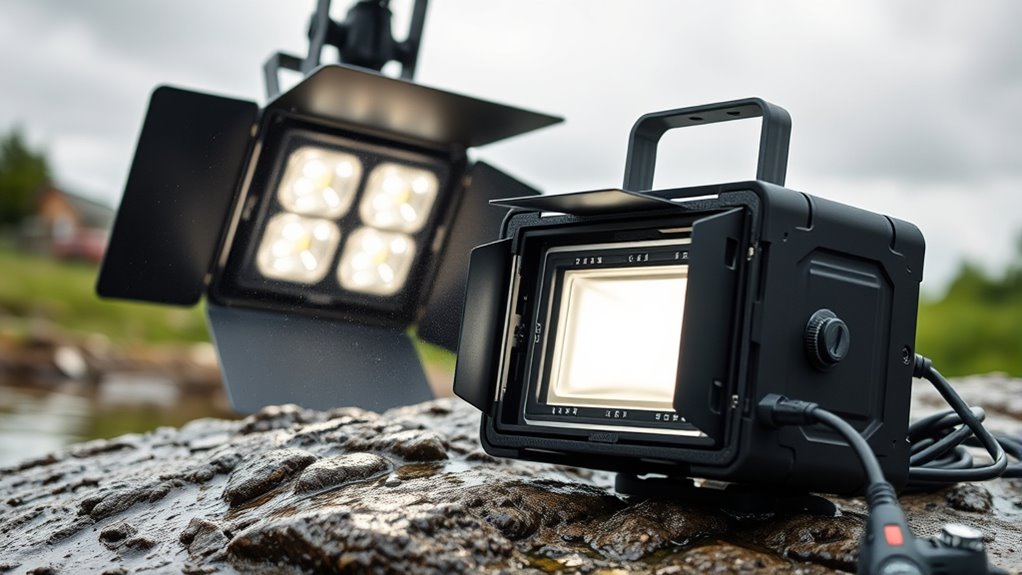
Using your lighting kit outdoors or in wet conditions requires careful consideration of its waterproof and weather-resistant features. Not all kits are built for outdoor durability, so check if yours has a high IP (Ingress Protection) rating. Weather resistance is essential to prevent damage from rain or humidity. Additionally, ensure the kit is designed for a remote work environment, which can enhance its suitability for outdoor use. Here are three tips to guarantee safe outdoor use:
Ensure your outdoor lighting kit is weather-resistant with a high IP rating to prevent damage from rain and humidity.
- Verify the IP rating—aim for IP65 or higher for outdoor durability.
- Protect connections with waterproof covers or enclosures.
- Avoid placing lights directly on wet surfaces or in standing water.
What Maintenance Is Required to Keep My Lighting Kit Ready for Emergencies?

Regular maintenance is essential to guarantee your lighting kit is reliable during emergencies. You should regularly check the battery maintenance, ensuring batteries are fully charged and free from corrosion. If your kit uses rechargeable batteries, test them periodically and recharge as needed. For disposable batteries, replace them once they show signs of weakness or after a set time. Proper storage tips also matter—keep your kit in a cool, dry place away from direct sunlight to prevent damage. Inspect your lighting equipment for cracks or damage and clean lenses to maintain brightness. Regularly testing your lights ensures they work when needed. Keeping a maintenance log can help track battery life and maintenance tasks, so your lighting kit is always ready when an emergency strikes.
Frequently Asked Questions
Are There Any Portable Lighting Kits Suitable for Camping During Blackouts?
Yes, there are portable lighting kits perfect for camping during blackouts. You can find compact, rechargeable options that fit easily into your camping essentials. These kits often include durable LED lanterns, headlamps, and flashlights, providing reliable light wherever you go. They’re lightweight, easy to carry, and designed for outdoor use, ensuring you stay safe and well-lit during blackouts or camping trips.
Can I Integrate My Blackout Lighting Kit With Home Automation Systems?
Ever wondered if you can sync your blackout lighting kit with your smart home? Yes, you can! Many modern kits offer automation compatibility, allowing you to control lights through your existing smart home system. Just check the product specifications for compatibility with your preferred automation platform. Once integrated, you can automate lighting schedules or control them remotely, making blackout preparedness seamless and smart.
What Is the Typical Cost Range for Beginner Blackout Lighting Kits?
A typical cost estimate for beginner blackout lighting kits ranges from $50 to $150, depending on the features and brand. If you’re on a tight budget, look for budget options that offer basic blackout capabilities without extra features. Higher-end kits with smart controls or additional accessories tend to be more expensive. Comparing prices and reading reviews can help you find the best value within your budget.
Do Lighting Kits Include Backup Power Sources Like Generators?
Did you know that only 35% of blackout lighting kits include backup power sources? Most beginner kits don’t come with generators; instead, they often feature battery backups or solar-powered options. You can easily add a portable generator if you want more power. Consider solar-powered lighting kits for eco-friendly, reliable backup, especially if you want a sustainable solution. Always check if the kit includes these backup options before purchasing.
How Do I Store My Lighting Kit Safely When Not in Use?
You should store your lighting kit in a cool, dry place to guarantee storage safety. Keep it away from direct sunlight, moisture, and extreme temperatures to prevent damage. Regularly check and maintain your kit by inspecting cables and bulbs for wear and tear. Proper storage and routine maintenance extend your kit’s lifespan, making it ready for use when needed. Always follow the manufacturer’s instructions for the best kit maintenance practices.
Conclusion
Having the right lighting kit can make all the difference during a blackout. For example, imagine using a solar-powered lantern that charges during the day and provides reliable light at night—keeping your family safe and comfortable. By understanding your options and following safety tips, you’ll be prepared for any power outage. So, choose wisely, maintain your lights, and enjoy peace of mind knowing you’re ready for the next blackout.
